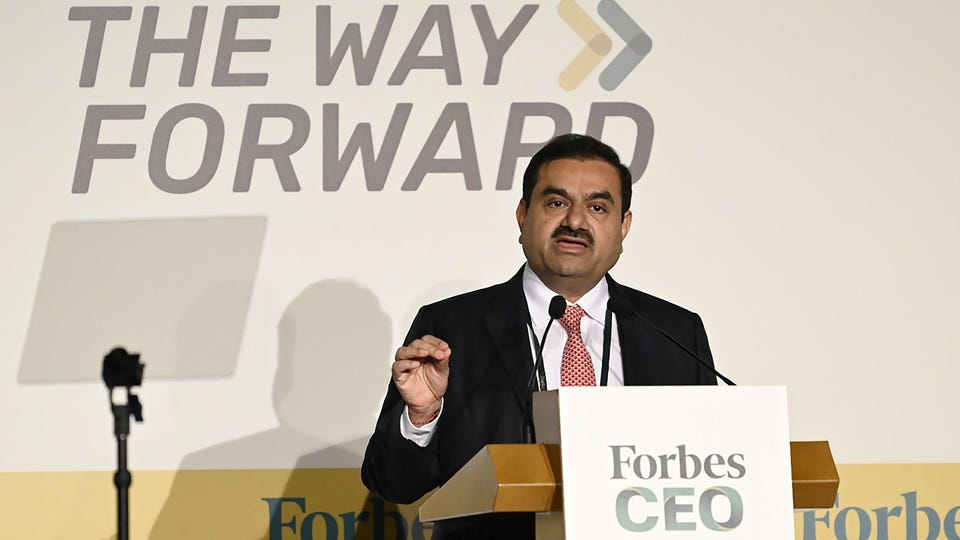Is India on track to become a $30 trillion economy? For perspective, we’re talking today’s U. S. , Japanese and Italian annual gross domestic product combined.
Or today’s combined Chinese, German, French, British and Canadian output. In other words, wow! Yet that’s where Indian billionaire Gautam Adani , chairman of Adani Group, sees his nation headed. And, really, the rest of us would be unwise to dismiss his take over where India’s $3 trillion will be decades from now.
Adani also reckons it’s India’s destiny to boast a $45 trillion stock market valuation. Arguably, the 60-year-old is better positioned than most to know. Based in Ahmedabad, his conglomerate–and fortune in the neighborhood of $100 billion fortune—has interests ranging from airports to cement to data centers to green energy to ports and more.
Now, he believes that India “will be a country that will be supremely confident of its position in the world,” Adani told the Forbes Global CEO Conference 2022 in Singapore this week. Yet it’s hard not to conclude that Adani’s real message is for another audience. His speech really needs to go to the government of Narendra Modi, which must set the stage for the future Adani wants.
But it seems there’s little indication Modi is succeeding on a scale necessary to morph India into the economy the nation’s business leaders are seeking. Few doubt that India is going places. A recent World Economic Forum notes that a decade ago, India was No.
11 in GDP terms. With India growing 7%, WEF, using International Monetary Fund data, notes it’s No. 5 globally, surpassing the U.
K. India also is experiencing something of a tech “unicorn” boom, leaving far more developed economies like Japan in the dust. Yet after 100 months in power, Modi’s economic reform legacy remains a modest one.
Since May 2014, Modi has indeed put some key upgrades on the scoreboard. Moves to open sectors from aviation to defense to insurance and others to increased foreign investment mark progress. So did overseeing the passage of a national goods and services tax.
But the truly epochal disruptions—laws on labor, land and taxation—remain works in progress. Pledges to clean up the bad loan troubles undermining state banks remain mostly that. And while tech startups are enjoying a “ golden era ,” as Modi likes to say, broader job growth needed to spread the benefits of GDP more widely continues to disappoint.
Such complacency isn’t unique to India. The idea that politicians’ work is done once GDP tops 5% is common from South Korea to the Philippines to Indonesia. Yet the boosterism that masks a lack of bold retooling means India suffers from some serious preexisting conditions as the global economy goes off the rails.
In the short run, “India’s economy is recovering nicely,” says analyst Udith Sikand at Gavekal Research. The problem, Sikand says, “is an adverse external backdrop that is hurting exports and leaving India’s capital markets vulnerable to another risk-off move as global liquidity tightens. For investors, the good news is that government bonds should continue to outperform for a while yet.
Caution is warranted on the Indian rupee, however, which remains vulnerable to a further leg down against the U. S. dollar.
” The currency risk angle is a live one. The rupee’s nearly 10% drop this year is less dramatic than declines in the Japanese yen or even the Chinese yuan. Yet at a moment when global commodity prices seem ready to skyrocket anew, it’s arguably the last thing New Delhi needs heading into 2023.
What’s more, a sliding rupee could hurt the segment of the economy that’s truly, objectively thriving. Already, rising costs are making it harder for many startups to scale up and to make profit doing business outside India. There’s also the risk every founder dreads: seeing their valuations fall out the unicorn club ranks.
That’s the thing about startups. Japan has scores and scores of them, not so many new unicorns. The trouble is that broader regulatory environments, corporate systems and economic realities can make it hard for the most innovative of small companies to grow into mid-size ones or giant ones.
To avoid such barriers, India needs all the disruption from the ground up it can muster. Billionaire Adani is now looking at India’s path toward $30 trillion status from the top down. Let’s hope Modi is listening and ready to step up the pace in raising India’s economic game.
.
From: forbes
URL: https://www.forbes.com/sites/williampesek/2022/09/30/indias-30-trillion-future-is-easier-said-than-done/



